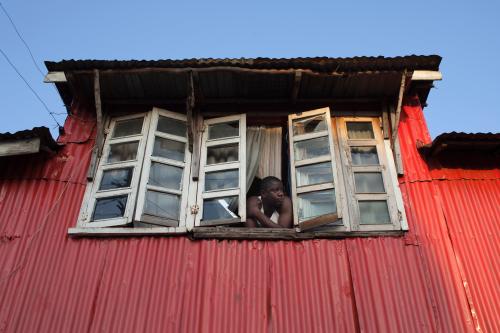On November 27, the House of Representatives passed the Global Fragility and Violence Reduction Act of 2018 (H.R. 5273) and brought the United States a step closer to a more focused, high-level policy response to address violence and instability in the world’s toughest places.
The creation of a targeted, rational U.S. approach to fragility rests on the fulfillment of three initiatives. First is the implementation of the administration’s Stabilization Assistance Review and National Security Strategy, both of which recognize the critical importance of addressing conflict and fragility. Second is the expected report in February 2019 of the Task Force on Extremism in Fragile States. The Task Force was requested by Congress and convened by the U.S. Institute of Peace (USIP). Third is to advance H.R. 5273, which passed the House with strong bipartisan and leadership support.
The stabilization assistance and national security reviews are high-level policy statements still to be translated into specific implementation policies and programs. More detailed recommendations can be found in both the specific language of the bill and in the Task Force interim report. A helpful summary of the Task Force’s insights so far appears in a December 4 op-ed in “The Hill” by the task force’s co-chairs, former Representative Lee Hamilton and former Governor Tom Kean.
Prevention
Both the interim report and the op-ed are focused not just on existing locales of extremism and fragility, but also on states that are sufficiently fragile that they could fall into violence and extremism. So, beyond stopping violence and extremism, they emphasize the importance of prevention—strengthening the resilience of communities and states to avoid the worst manifestations of fragility.
The how
Both initiatives are appropriately emphasizing the How over the What. They recognize that How assistance and support are provided is actually more important than What it is used for. If the development community has learned anything the past several decades, it is that when assistance fails to meet local needs and wishes, it will not fulfill its goals. Recipients will accept the assistance pro forma, but likely ignore the outputs. If assistance is not adjusted to changing needs and circumstances, again, it will be ineffective, even counterproductive.
So both initiatives have at their core the important concepts of local ownership and priorities, flexibility, agility, and learning. Assistance should be built around engaging local actors—government, private sector, and civil society—and not just in a one-off consultative mode. Rather, active engagement is required from planning, to design, to implementation, to evaluation. Congressional legislation should confer flexibility to implementers and administrators so they can adapt to local and changing conditions. Projects must be subject to ongoing monitoring, with periodic check-ins with recipients to see if the support is fully utilized and useful. Implementers and administrators need the authority to undertake mid-course adjustments so intended objectives can be met. The data and information from that monitoring and evaluation should in turn inform subsequent activities.
Flexibility
Congress is essential to providing the necessary flexibility and agility. The House-passed bill includes a directive that the administration should work with Congress to allow for adaptive programming through exemptions from specific and minimum funding levels, i.e. earmarks. The Senate bill (S.3368) goes a step further in actually providing that exemption for the assistance initiative authorized by the legislation. The initiative as defined by the bills is “10-year plans of action” for the priority countries identified as either “core countries” (with high levels of violence and fragility) or “prevention countries” (with signs of potential violence and fragility). So the Senate exemption would apply to the range of assistance that the U.S. provides to a designated country, as appropriate.
Given the traditional lack of full trust between the legislative and executive branches of government, what is going to incentivize Congress to provide this flexibility?
Incentive
The incentive comes from the dire threat violence and fragility pose to regional and global peace and stability. Public policymakers also should be motivated by overwhelming evidence that effective responses are best identified in the field, and must adjust to changing circumstances. In addition, career staff at USAID, the Millennium Challenge Corporation, State Department, and other government agencies, along with their partners in civil society and the private sector, have learned that some of the most enduring answers come from listening to and working with local actors.
Confidence
As to confidence, that is in part provided in the legislation; the other half has to come from the administration. The bills require the administration to submit the assistance initiative to the Congress for its review and for regular consultation thereafter. They are explicit in requiring clear, transparent, and measurable benchmarks, timetables, and performance metrics—all of which can be used to assess whether assistance is being used in an appropriate and effective manner. They further require “monitoring and evaluation, adaptive management, and iterative learning.”
These requirements in the bills offer a foundation for building congressional confidence. In reviewing the proposed initiative, Congress can evaluate and weigh in on the benchmarks and performance metrics, recognizing that, for fragile states, much of this information comes not from hard numeric data but from rigorous analysis. And Congress can insist that, with the emphasis in the bills on transparency and regular consultation, it be kept fully informed on any alterations in the plans and have full and timely access to evaluations (which must be built in at the planning stage of projects). The relevant authorizing and appropriations committees could even designate specific members and staff to be regular recipients of this information and consultations. Further, the reform agenda on procurement and partnering that Administrator Mark Green is leading at USAID offers the expectation that the agency will be more adaptive and agile in building resilience in fragile environs.
Three-legged stool
These three venues for action are converging at a critical moment. Evolving administration policies underpin an understanding of how critical stability is to global peace and prosperity. The Task Force report and background documents provide the intellectual foundations and rationale for a coherent approach to addressing the underlying sources of fragility. The legislation, inherently consistent with the direction of the Task Force, provides the authority for a comprehensive assistance plan to address violence and fragility in key countries, including those vulnerable states still clinging to a semblance of stability.
The missing piece is the Senate passing S.3368, a nearly identical version of the House passed bill. Senate action in the waning days of the 115th Congress will complete this triad.







Commentary
The US is closing in on a coherent approach to fragility
December 10, 2018